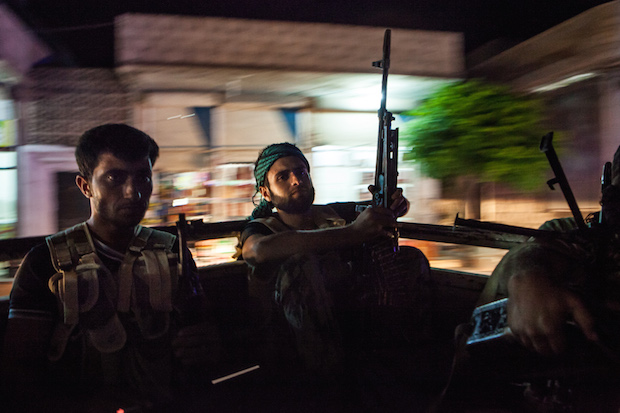Yesterday David Cameron told Parliament that there are ‘about 70,000 Syrian opposition fighters on the ground who do not belong to extremist groups’ who could help fight Islamic State.
The Prime Minister’s number was the result of an internal assessment made by the Joint Intelligence Committee (JIC), backed up by serving British diplomats overseas whose jobs focus on the Syrian opposition. Such a large number struck many as political exaggeration. The chairman of the Defence Committee, Julian Lewis, said he was ‘extremely surprised’. Labour leader Jeremy Corbyn may issue a formal demand for clarification. So do these fighters exist and who are they?
Of course, the debate primarily centres around the issue of what it means to be a ‘moderate armed opposition group’ in Syria. Notwithstanding the storm surrounding this morning’s statement, this question has become particularly pertinent in recent days, as international diplomats discuss who should – and should not – be involved in a future Syrian peace process.
As diplomatic efforts for Syria gain pace and as Saudi Arabia prepares to host a major conference bringing together 60-80 representatives of a broad spectrum opposition, the definition of “moderate” has been shifting. The most effective definition now must be based upon a combined assessment of (a) what groups are acknowledged as being opposed to ISIL and (b) what groups our governments want, or need to be involved in a political process.
Having studied Syria’s armed opposition since the first months of the country’s uprising in mid-2011, I can say with confidence that the Prime Minister and the JIC are about right.
Many of the groups who fall within both these categories are armed factions the Islamist-averse United States’ CIA has already ‘vetted’ and assessed as ‘moderate’ enough to receive lethal assistance. Some others are recognised by Syrians as ‘mainstream’ members of the revolution – some moderately Islamic – and crucially, as being strongly rooted within local societies. Combined, these factions likely represent roughly 65,000 fighters. Representatives of all these groups look set to be invited to Saudi Arabia’s internationally-facilitated opposition conference in early-December. They are as follows:

While unlikely to be invited to grand opposition conferences abroad due to their comparatively smaller size, there are roughly 25-30 additional factions that would fall under this ‘moderate’ label. Combined, these factions represent another 10,000 fighters.
Making a total of 75,000 fighters, these 105-110 factions broadly represent what one could today label as ‘moderate’ in Syria’s context. This means they are explicitly nationalist in terms of their strategic vision; they are local in terms of their membership; and they seek to return to Syria’s historical status as a harmonious multi-sectarian nation in which all ethnicities, sects and genders enjoy an equal status before the law and state. They remain focused on fighting the Assad regime, however, as it represents a more immediate priority for most, in terms of self-protection, the defence of civilian populations and of course, pursuing the revolution’s ultimate objective. Beyond these factions, it becomes more complicated.
The biggest challenge for policymakers today is ensuring that any future political agreement on Syria is agreed and signed onto by those genuinely capable of enforcing it on the ground. Beyond the aforementioned armed factions, two ‘supergroups’ currently dominate opposition dynamics in Syria – Jaish al-Islam and Ahrar al-Sham. Both are avowedly conservative Islamist movements and combined, field a total of roughly 27,500 fighters. Although the U.S. has for several years banned its diplomats from engaging with the more conservative of the two – Ahrar al-Sham – both it and Jaish al-Islam look set to be invited to Saudi Arabia’s opposition conference. Turkey, Qatar and Saudi Arabia even tried to bring leading representatives of both factions to the most recent ministerial talks in Vienna, on 14 November.
Both of these groups and perhaps a small number of others are definitely not natural Western allies, no doubt about it. But they vehemently oppose ISIL being in Syria and have fought it successfully in the past – with far better results than our currently favoured allies, the Kurds. They have also proven willing behind the scenes to submit themselves to being single components of a broader opposition – or revolutionary – movement. Should they be included in a formal political process, they will become one of many factions involved. Should they be excluded, they could become immensely powerful spoilers.
Had the West more definitively intervened in Syria early on, we would undoubtedly have more moderate, more cohesive and more natural ally-material opposition to work with. Unfortunately, things took a different path. Our subsequent obsession with the extremists and refusal to tackle Syria’s complexity has clouded our vision. A ‘moderate’ opposition in culturally attuned terms does exist in Syria, we need only open our eyes to it. Only these groups – and certainly not Assad – will ensure the real extremists such as ISIL and Al-Qaeda eventually lose their grip on power in Syria.
Charles Lister is a Visiting Fellow at the Brookings Doha Center and a Senior Consultant to The Shaikh Group. He has spent the past two years coordinating an intensive process of face-to-face engagement with the leaderships of over 100 Syrian armed opposition groups, as one component of a multinationally-backed Track II process. His new book, The Syrian Jihad: Al-Qaeda, the Islamic State and the Evolution of an Insurgency was published in November 2015.






Comments